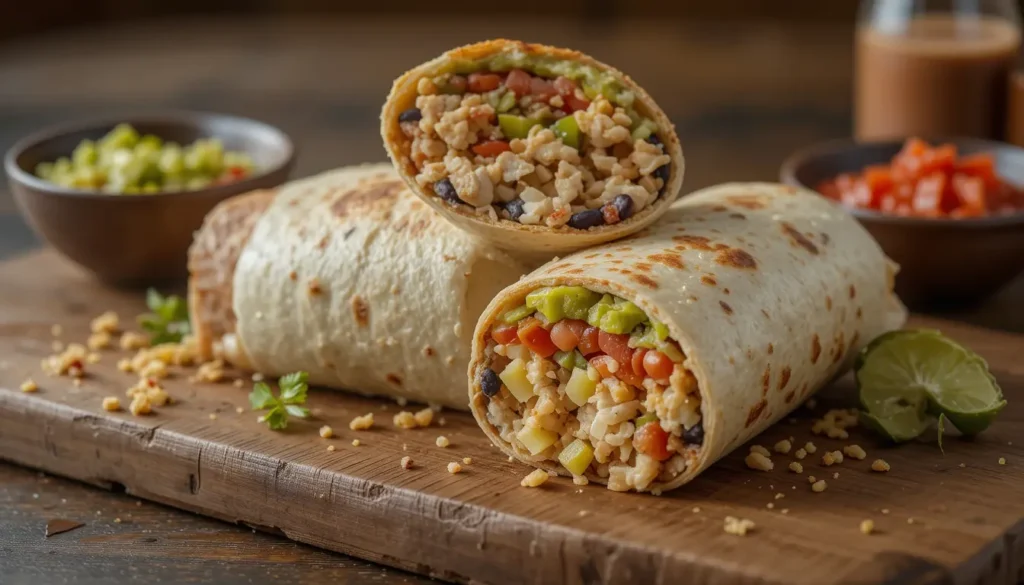Burritos are a quintessential favorite for many food lovers. They’re portable, flavorful, and endlessly customizable. But have you ever wondered What Are the Most Common Ingredients in a Burrito? Let’s take a deep dive into the most common ingredients in a burrito and why they matter, from the humble tortilla to the bold spices that tie it all together.
Table of Contents
Burrito Ingredients
When you think of burritos, what comes to mind? For most, it’s the satisfying combination of a warm tortilla, hearty fillings, and a mix of flavors and textures. Whether you’re crafting one at home or ordering from your favorite spot, the ingredients are key. These layers create the magic and determine if a burrito is good or absolutely unforgettable.
The Anatomy of a Perfect Burrito
Every burrito has a foundation—a structure that makes it a burrito and not just another wrap. Think of it like building a house. Without a strong base, the entire thing falls apart. And no ingredient is more foundational than the tortilla.
Understanding the Foundation: Tortillas
Tortillas are where it all begins. They serve as the edible envelope that holds everything together. Traditionally, burritos are made with flour tortillas, which are softer and more pliable than their corn counterparts. Why? Because a good tortilla wraps tightly, creating that seamless bundle of deliciousness we all know and love.
Types of Tortillas Used in Burritos
Though flour tortillas dominate, there are variations to suit different dietary needs and flavor preferences. Some people opt for gluten-free tortillas made with almond or cassava flour. Others experiment with flavored tortillas like spinach or sun-dried tomato for an extra twist. The choice here sets the tone for the rest of the burrito.
Core Protein Choices in Burritos
If the tortilla is the shell, then the protein is the heart of a burrito. It’s where much of the flavor and substance comes from. Among the most common ingredients in a burrito, traditional choices include beef ore chicken, but vegetarian and vegan alternatives have become just as popular.
Beef and Its Variants
Beef is a classic for a reason. Ground beef seasoned with spices or slow-cooked brisket gives a rich, savory base. Carne asada, marinated and grilled to perfection, often steals the show with its smoky, bold flavor.
Chicken: A Versatile Option
Chicken burritos are like the “jack of all trades.” They work for almost everyone and can range from shredded chicken cooked in salsa to grilled, seasoned chunks. It’s light but satisfying and pairs well with almost any filling.
Vegetarian and Vegan Protein Alternatives
Not a meat eater? No problem! Plant-based proteins like black beans, lentils, or tofu work wonders. Recently, plant-based meat substitutes such as jackfruit or soy crumbles have gained popularity for their ability to mimic traditional flavors and textures.
Essential Base Fillings
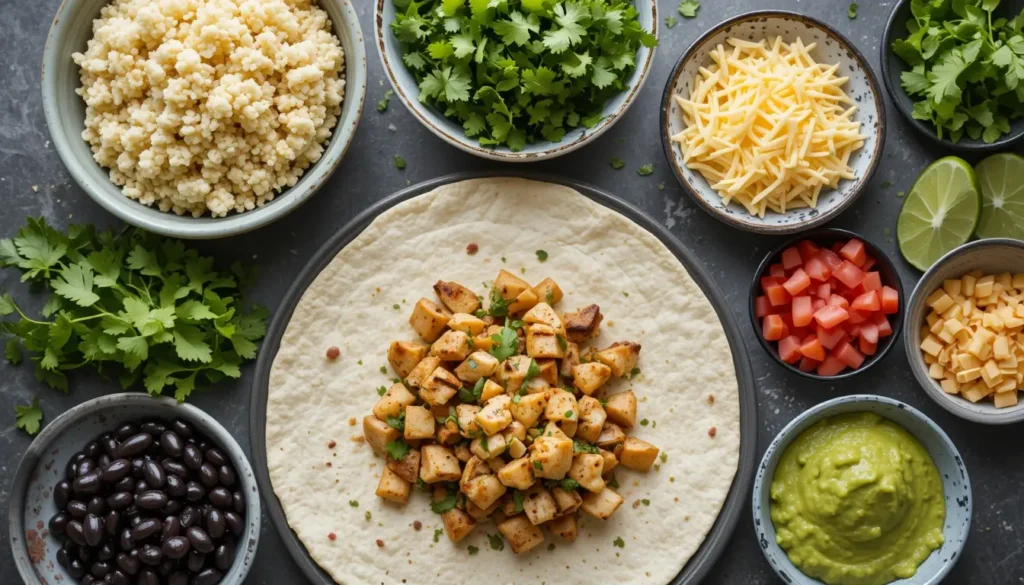
After the protein comes the base fillings, which provide bulk and flavor. Rice and beans are non-negotiable for many burrito lovers. They’re the backbone that gives a burrito its hearty texture and taste.
Rice: Types and Flavor Variations
Rice might seem simple, but it’s far from boring. Some prefer white rice with a hint of lime and cilantro, while others swear by the depth of Spanish rice cooked with tomatoes and spices. Whatever the choice, rice adds that starchy balance that pairs perfectly with the rest of the ingredients.
Beans: Black, Pinto, and Refried
Beans are another burrito staple. Black beans are earthy and slightly sweet, while pinto beans bring a nutty flavor. Refried beans, often cooked with lard for richness, deliver a creamy consistency that ties everything together.
The Role of Fresh Vegetables in Burritos
Now comes the crunch. Vegetables add freshness and texture, balancing the heavier ingredients. Without them, burritos can feel overly rich or one-dimensional.
Lettuce and Greens
Lettuce, often shredded romaine, adds a light, crisp texture. Sometimes, burrito makers opt for spinach or mixed greens for a subtle twist. While greens might seem secondary, they’re the quiet heroes that freshen up every bite.
Tomatoes and Salsa Options
Tomatoes bring juiciness, but salsa? That’s where the real magic happens. From mild pico de gallo to fiery habanero blends, salsa injects layers of flavor, heat, and brightness into the burrito.
Onions and Peppers
Onions, whether raw, caramelized, or pickled, add a kick of flavor. Peppers—like bell, poblano, or even jalapeños—contribute sweetness or spice, depending on the variety. Together, they create a symphony of flavors.
Complementary Add-Ons for Flavor
What takes a burrito from “good” to “mind-blowing”? The extras. Complementary add-ons are like the icing on the cake—they enhance flavor, add texture, and create a unique eating experience.
Cheese: Shredded and Melty
Cheese is a burrito essential for many, offering richness and a creamy texture. Classic choices include shredded cheddar, Monterey Jack, or queso fresco. Some prefer it melted directly into the fillings, creating gooey pockets of deliciousness, while others sprinkle it on top for added flair.
Guacamole and Avocado Slices
Is there anything better than creamy guacamole? It’s like burrito gold—luxurious and satisfying. Some people prefer fresh avocado slices for a simpler option, but both add a buttery texture and subtle richness that balance the spicier elements of the burrito.
Sour Cream and Yogurt Alternatives
Sour cream is another favorite, offering a tangy contrast to the savory fillings. For those seeking a lighter or dairy-free option, Greek yogurt or plant-based alternatives work just as well. These creamy toppings are cooling agents, making them perfect for burritos with a spicy kick.
Spices and Sauces That Elevate Burritos
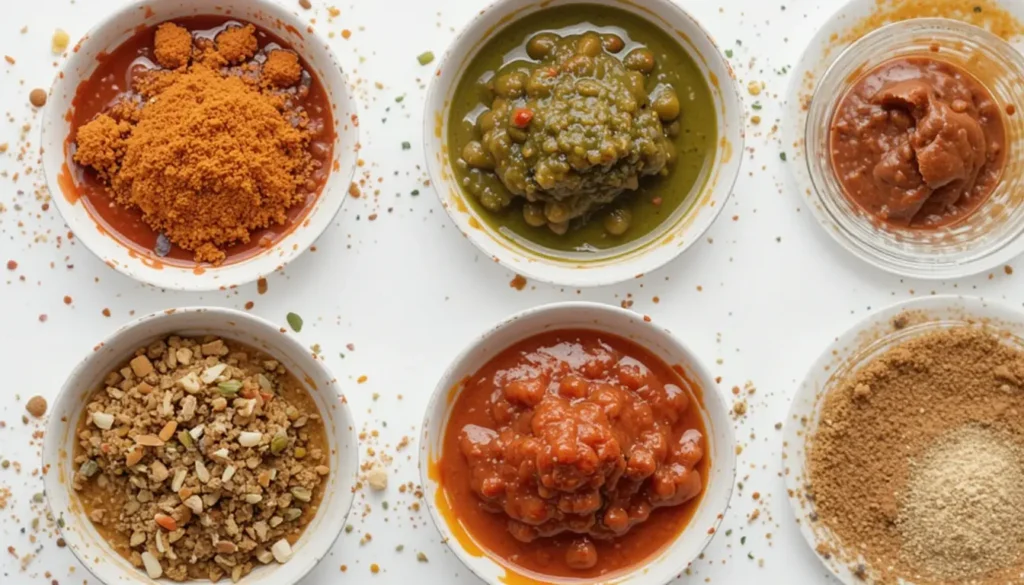
Spices and sauces are the finishing touch—the magic that brings all the flavors together in the most common ingredients in a burrito. They add depth, complexity, and even a bit of heat.
Traditional Mexican Spices and Seasonings
Think cumin, chili powder, paprika, garlic, and oregano. These spices are the backbone of traditional Mexican cuisine, giving burritos their distinctive warmth and flavor. A well-seasoned protein or bean base can make or break the dish.
Popular Burrito Sauces
Sauces are where you can truly customize your burrito. A drizzle of smoky chipotle sauce, a splash of tangy tomatillo salsa, or even a dollop of mole can take the flavor profile to a whole new level. Hot sauce lovers might add a few dashes of their favorite brand for that extra zing.
Variations by Region and Style
Not all burritos are created equal. The ingredients and style can vary widely depending on where you are, with each region putting its own spin on this classic dish.
California-Style Burritos
California burritos are famous for their hearty, over-the-top fillings. Often, they include carne asada, cheese, and—you guessed it—french fries. This regional favorite is all about indulgence, offering a fusion of textures and flavors that make it unforgettable.
Tex-Mex Burritos
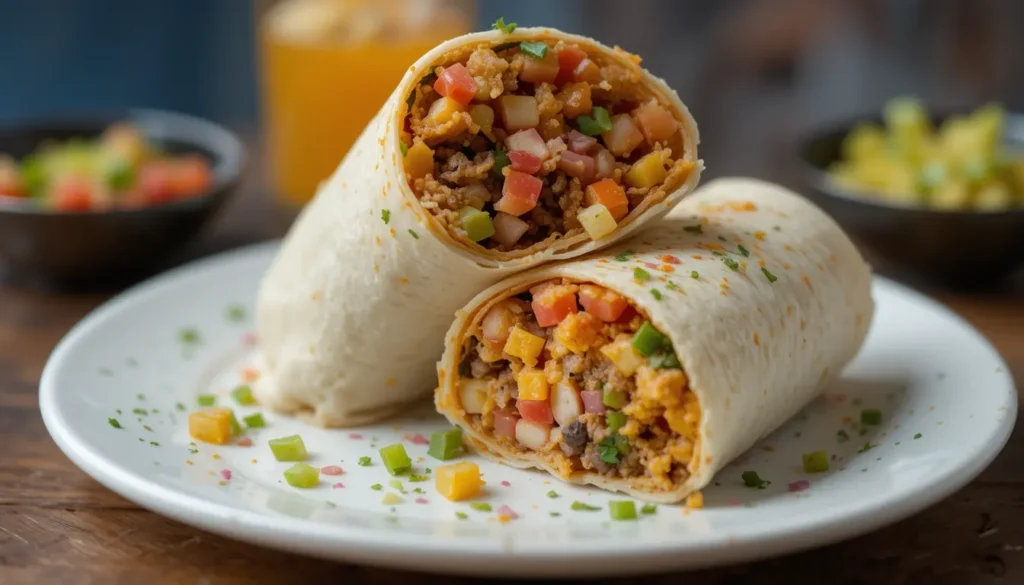
Tex-Mex burritos lean into bold, cheesy flavors with generous portions of beans, rice, and spiced meat. These burritos often come smothered in sauces like queso or chili, making them a knife-and-fork affair rather than a handheld meal.
Authentic Mexican Burritos
In contrast to their Americanized counterparts, authentic Mexican burritos are usually smaller and simpler. They often include just a few ingredients, such as beans, meat, and a bit of salsa, wrapped tightly in a flour tortilla. The focus is on quality over quantity.
Common Problems When Making Burritos
While burritos might seem straightforward, mastering the most common ingredients in a burrito can be tricky. Several common problems can arise during preparation, affecting the balance, flavor, and structure of your burrito.
Overstuffing and Wrapping Issues
Ever had a burrito burst open mid-bite? Overstuffing is a common mistake. It’s tempting to pile in all your favorite ingredients, but too much filling makes the tortilla difficult to wrap and prone to tearing.
Ingredient Imbalance
Another challenge is achieving the right balance of ingredients. Too much rice can make the burrito feel dry, while overloading on salsa might result in a soggy mess. The key is proportion and careful layering.
Dryness or Lack of Flavor
A dry burrito is a sad burrito. This often happens when there’s not enough moisture from sauces, salsa, or other ingredients. On the flip side, under-seasoned fillings can make a burrito taste bland, no matter how perfectly it’s wrapped.
Solutions to Perfect Your Burrito
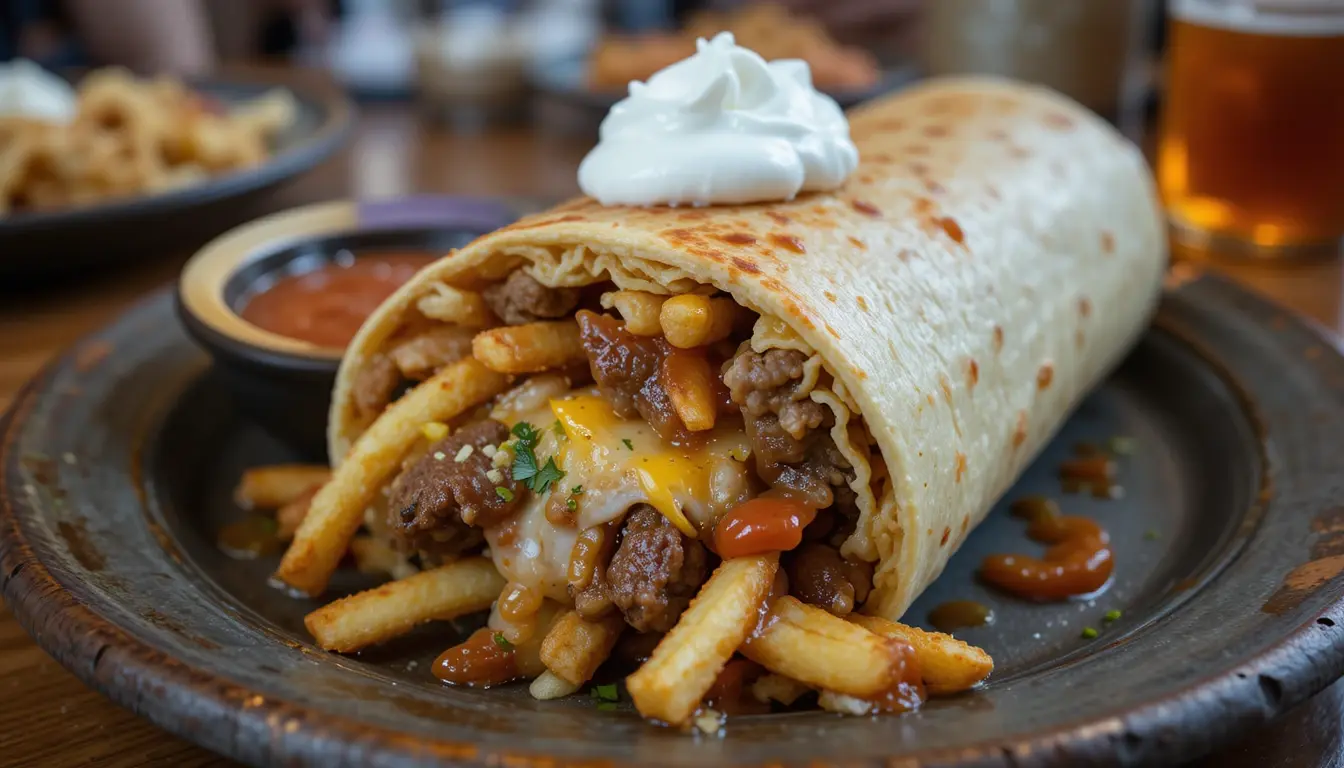
Every problem has a solution, and with a few simple tweaks, you can level up your burrito game and ensure you’re using the most common ingredients in a burrito effectively. By refining your technique and ingredient choices, you can create a masterpiece every time.
Tips for Proper Wrapping
Wrapping a burrito is an art. Start by warming your tortilla—it makes it more pliable. Place the filling in the center, leaving enough space on the edges to fold over. Tuck in the sides, then roll tightly while keeping everything secure. Practice makes perfect!
Achieving a Balanced Flavor Profile
To get the perfect bite every time, layer your ingredients thoughtfully. Alternate textures and flavors: place creamy elements next to crunchy ones, or spicy ingredients near cooling components. This way, every mouthful is harmonious.
Enhancing Moisture and Freshness
Incorporate moisture-rich ingredients like guacamole, salsa, or sauces. Avoid overcooking proteins or beans, as they can become dry. And don’t forget to use fresh vegetables—they brighten up the dish and make it more enjoyable.
Healthier Burrito Options
What are the most common ingredients in a burrito don’t have to be calorie-heavy or indulgent to be delicious. With a few tweaks, you can enjoy a healthier version of this classic dish without sacrificing flavor. Whether you’re aiming for low-carb, gluten-free, or just a lighter meal, there are plenty of options to suit your preferences.
Low-Carb and Gluten-Free Tortillas
For those avoiding carbs or gluten, the tortilla is often the first thing to modify. Many stores offer low-carb tortillas made from almond flour, coconut flour, or even cheese wraps. For a gluten-free option, corn tortillas or cassava-based wraps are excellent substitutes. If you want to go completely carb-free, consider wrapping your burrito in large lettuce leaves or collard greens.
Nutritional Swaps for a Guilt-Free Treat
The fillings are where you can make the biggest impact on nutrition. Swap white rice for quinoa or cauliflower rice to reduce carbs and boost fiber. Use lean proteins like grilled chicken or tofu instead of fattier meats. Opt for light cheese or skip it altogether and add extra avocado for creaminess. Replace sour cream with Greek yogurt for a tangy but lower-calorie alternative.
For an extra health boost, load up on vegetables. Bell peppers, zucchini, and spinach can add bulk without extra calories. The key is finding a balance between indulgence and mindful eating.
FAQs
What is the most important ingredient in a burrito?
The tortilla is arguably the most important ingredient in a burrito because it holds everything together. A soft, pliable flour tortilla is ideal for creating a tightly wrapped, flavorful burrito.
Are burritos healthy?
Burritos can be healthy depending on the ingredients. Using lean proteins, fresh vegetables, and whole-grain tortillas can make them a nutritious choice. Avoiding heavy sauces and excess cheese can also reduce calories and fat.
What makes a burrito authentic?
An authentic Mexican burrito typically includes a small flour tortilla filled with simple ingredients like beans, meat, and salsa. Unlike American-style burritos, they are usually smaller and less elaborate.
How can I prevent my burrito from getting soggy?
To avoid a soggy burrito, make sure to drain any excess liquid from your fillings, especially beans and salsa. Layering rice or lettuce as a barrier can help absorb moisture and keep the tortilla intact.
What are some vegan-friendly burrito options?
Vegan burritos can include fillings like black beans, rice, grilled vegetables, guacamole, salsa, and plant-based proteins like tofu or tempeh. Nutritional yeast can be used as a substitute for cheese.
Can I make burritos ahead of time?
Yes, you can make burritos ahead of time and store them in the fridge or freezer. Wrap them tightly in foil to keep them fresh. When reheating, use an oven or skillet for the best texture.
Final Thoughts on Burrito Ingredients
A burrito is more than just a meal—it’s a culinary canvas. With so many ingredients to choose from, the combinations are endless. Whether you love the simplicity of an authentic Mexican burrito or the extravagance of a California-style creation, the core elements of what are the most common ingredients in a burrito remain the same.
The tortilla is the base that holds everything together, while the protein, rice, beans, and vegetables form the flavorful core. Add-ons like guacamole, cheese, and spices take the experience to the next level. By balancing these components and paying attention to quality, you can create a burrito that’s perfectly tailored to your tastes.
The next time you’re in the kitchen or at your favorite burrito joint, take a moment to appreciate the artistry that goes into this beloved dish. From the first bite to the last, each ingredient plays its part in delivering a meal that’s satisfying, versatile, and undeniably delicious.
For a deeper dive into related recipes, explore Empanadas Venezolanas – A Culinary Delight.
Discover how cheese elevates recipes in The Ultimate Guide to Grilled Cheese Burrito.

